Research Division
Reprinted from "INSULATORS - Crown Jewels of the Wire", February 1972, page 19
Dear Editor,
I have an insulator that is not found in any of my books. It is a triple
petticoat, saddle groove, power insulator.
The front embossing reads:
HEMINGRAY
PATENTED MAY 2
1893
The rear embossing reads:
HIGH VOLTAGE
TRIPLE PETTICOAT
No 4
It is blue green with with dimensions. sharp drip points. Below is a drawing
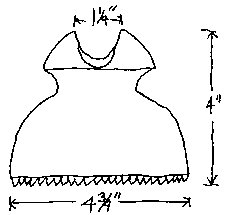
I would like to know the value of this insulator. If you or any of your
readers could tell me this I would greatly appreciate it.
Thank you,
Grant Roberts
6818 Garth ~d. S.E.
Huntsville, Alabama 35802
Dear Editor,
I have several H.G. Co. signals with Patent May 2 1893 on the front and
petticoat on the back. However, one has a curious design on the back.
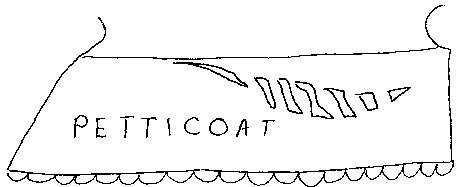
The lines of the design are slightly raised. I have been un-able to
obtain any information on this design. Can you help me out.
Sincerely,
Gary Turner
P.O. Box 25
Warren, Ore. 97053
Dear Dora,
I thought your readers might be interested in an insulator I bought in an
antique store in St. Louis. It is a CD 272 NO NAME, aqua. No one I've asked
about this insulator knows anything of it, and I cannot find it listed in any
book.
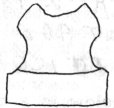
I would really appreciate hearing from you or anyone having one of these
insulators or knowing anything about It.
Sincerely,
David Gray
408 Wyncrest Dr.
Manchester, Missouri 63011
Dear Editor,
Received my Dec. issue and am still pleased with this book.
I am a collector of signal type Brookfields. I have several with embossing on
dome, and some with or without inner skirt. I realize that there are many
varieties. My question is how do I tell the age of these different types and
embossing. I have Tibbetts' Vol. #1, #2, #3 and Schroeder's "800
Insulators" to use as reference. I need to know if other books can give me
more information on dating these insulators? I would appreciate your help.
I hope to enter my collection in the Southern California Exposition at Del Mar,
California, in June-July.
Thank you,
Maury G. Tasem
519 Verdin Street
El Cajon, California 92021
I thought I heard rumors some time ago about a book to be published on old
Brookfields?? What happened? We really need one.
Your Editor
I have received numerous letters concerning my October, 1971 article on the
bar or dash marked insulaters.
Most of the letters have agreed with my conviction that they are all Hemingray
units. One disagreement, stating at least a few, are K.C.G.W. units. One unit
belongs to Jack Snyder of Toledo, Ohio. He owns a short beehive with a bar on
each side and believes it to be made by K.C.G.W., due to its shortness in size.
Snyder also owns a CD 124, embossed F-I B-i, a new shape.
Robert Nobbe of Conneraville, Indiana, owns a few of the mentioned CD 106's and
CD 145's. Nobbe is convinced that these units were produced by Hemingray, due to
the "H" on the dome of the CD 145's.
A note from Mrs. Isaac Blevins of Castle Bock, Washington, said that all of
the CD 210 Postal units with drip points, that she has seen, have had the
vertical dash. I have seen a few which had drip points without the dash at a
bottle show in Indianapolis last year. Mrs. Blevins also wanted to know the color of my CD 210 Postal. It is a Hemingray aqua green, not the
deep blue green used in Brookfield products of the same time. Also a few
Brookfields I have noticed have bits of particles and other foreign matter in
the glass.
A new, but not too uncommon, shape has been reported by L. B. Winfield of
Memphis, Tennessee, Kelly Bridges of Hattiesburg, Mississippi, and Bay's Bock
Shop in Drummond, Montana. It is a CD 151, embossed F- I B-I , without drip
points, in aqua. Dimensions are 4" x 3-7/16", with 5/16" dashes.
Bridges reports his CD 151 unit is embossed F- I, B-i ~, that's with each dash
accompanied by a small "8". He also owns a beehive with a small
"8" next to the dash.
With all these shapes similar to known Hemingrays, I will stick to my guns"
and say that they are of Hemingray manufacture, until someone comes up with a
catalog from some
company which shows the embossing on the units that reads F-~ B-I.
Keep the cards and letters coming in. I would like to know if there are any
other shapes not previously mentioned. I would also like to thank L. B.
"Pat" Winfield for mailing me a CD 210 Postal with the dash and sharp
drip points. I appreciate all the response I have received.
Good Collecting,
Paul F. Mohrs
Fairbanks Hall 312
Terre Haute, Indiana 47809
Dear Dora,
Well, I have two possibles, one a story of what kind of insulators were used on
the trans-continental railroad, and a question about a CD 121 SCA that is
identical to the Am. Tel. & Tel. , but it isn't embossed.
On some AT&T's, if you look very closely, you can see a grid pattern on the
glass--very small and very unnoticeable -- about 1/loath of an inch square. I
suppose it was the material the mold was made of, or the way it was made. But it
can only be found on almost unweathered AT&T's and this unembossed type like
mine. One can assume this must be by the same company as the AT&T's. It is a
deeper SCA than any AM. TEL & TEL'S I have ever seen, but not near royal
purple. So I figured it was a sample order
(earliest), and after this it was standardized and embossed.
Any ideas?
Today I was looking through a book called Railroads--In the Days of Steam,
and in this book are printed many Civil War pictures and many pictures from the
Trans-continental railroad. Enclosed are two sketches. Below is pictured the
first type of insulator used, consisting of two rams horns
(type unknown) in opposite ends of the bottom of the crossarm, and the crossarm
was secured by two bolts. This was an 1865 picture.
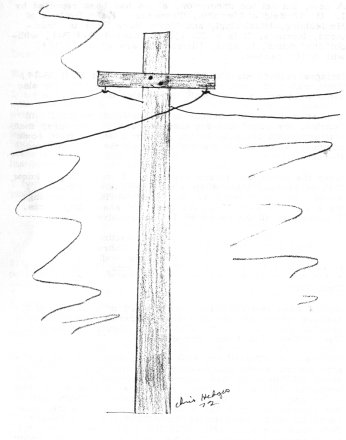
This sketch, from an 1869 picture, shows a pole with two crossarms with rams
horns and four large undistinguishable types, probably In the CD 126 area.
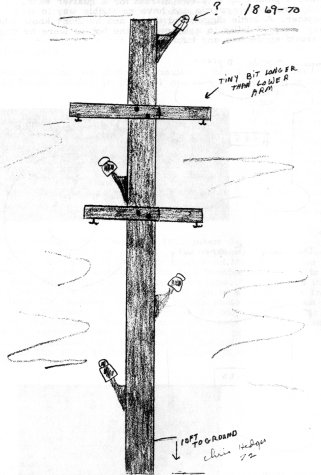
Keep up the great work.
Sincerely,
Chris Hedges
K.C., MO.
Dear Dora,
I am enclosing a drawing of two two-piece "thingamagigs" which I
picked up at a flea market for a quarter each. They are white ceramic and have
no visible way to stay together. A bottle digger had them, and he didn't know
what they were. I failed to ask how old the bottles were he dug. I would
appreciate any information.
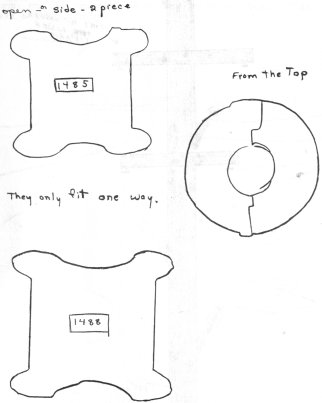
I enjoy your magazine, but all the different insulators people have found are
giving me a complex. I started off hoping to have one insulator from each
company. Now I see that's impossible.
I wish you would find out if there's a binder company that would sell them to
Crown Jewels. The two I have for Relic Magazine are so convenient.
Sincerely,
Imogene Peele
514 McLeod
Selma, Alabama 36701
Dear Dora:
Am enclosing two photos of insulators that I haven't seen in the books before.
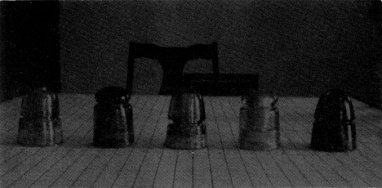
In photo #1 are two large pony type insulators, one in aqua, and one in SCA.
These I call the Hemingray first, as they are identical to the insulator in Gary
Cranfill's book two, page 39. The two insulators in this photo have no
embossing.
However, there is one that has the Dec. 19, 1871 patent date, but I am still
trying to capture it at present. I have placed three beehive CD 145 insulators
in the photo to give an idea of the size of
these pony type insulators. The first beehive on the left is a Brookfield mold
line over the dome type. The beehive in the center is a Calif. , and the last
one is an American Insulator Co. beehive. The lines in this photo are one inch
apart. At present the SCA pony is the only one known to have been found. These
two Insulators are of a three piece mold design with the mold line going to a
point just above the wire groove, and they have the flat collar type thread
start. The glass in these two insulators is thick and quite crude.
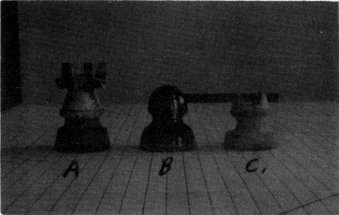
As for photo #2. The first item (A) is what I believe to be one of the rarest
trolley type insulators that I know of. The bottom is comp. type dingo
insulating material, having an inner skirt.
The top is solid bronze. The embossing is upside down, reading G.E. Co.
PATENTED JUNE 5-94. It has four prongs sticking up on the saddle top on each
side. In the photo one is in front of the other, making it look like only three.
Item ~ is what we call an unembossed Edison, 4" wide x 4-3/4" tall,
and has two Inner skirts. Not real rare, but a fairly good insulator. Item
"C" is all comp. and does not have an inner skirt. It Is embossed on
the bottom G.E. Co. PAT. #'s? Some gone. It is also embossed M.P. and more #'s.
Will send more interesting items in my next letter--like a copy of Mr. Morse's
first telegram with all the dots and dashes, etc., and Mr. Alexander Graham
Bell's first telephone. Also what happened to Mr. Tillotson's place of business.
That's about it for now.
Best regards,
Frank R. Jones
The Cottontown "Pole Cat"
Although the picture isn't too clear, we thought our readers, especially
lineman, would enjoy this little newspaper clipping.
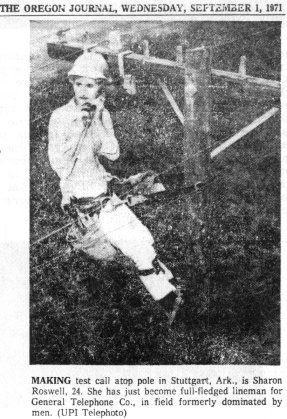
|
